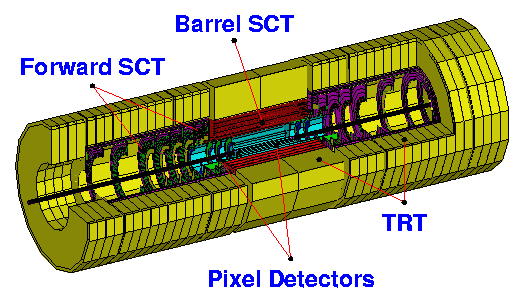University of Pennsylvania ATLAS Group

Inner Detector and the Transition Radiation Tracker
Tracking of the individual particle trajectories in the
ATLAS experiment is provided by the Inner Detector, which is shown below.
It consists of three layers of pixel detectors, four layers of silicon
strip detectors, and a Transition
Radiation Tracker comprised of approximately 425,000 straw proportional
tubes, which provides both tracking and transition radiation detection.

Electronics for the TRT (Transition Radiation Tracker)
The University of Pennsylvania has a major responsibility
for the on-detector electronics for the TRT, as well as for participating
in the overall system design. Key elements of the on-chamber electronics
include the development of two custom integratead circuits, the ASDBLR
which provides amplification/shaping, baseline restoration and discimination
and the DTMROC, which provides 16 channels of time measurement (1 nsec
resolution), Level 1 pipeline, buffers for event readout, and threshold
control and testpulse injection for the ASDBLR's.
The following links will take you
to an overview of the TRT as well as to summary information on several
aspects of the on-detector electronics. A few of the links are still under
construction.
ATLAS TRT overview
ASDBLR Integrated
Circuit
DTMROC Integrated
Circuit
On-Detector Printed Circuit Boards
2004 Tests with Barrel Module Sector at Penn
System Design
System Performance
People
Analog and Digital PCB for ATLAS given at NSS03
ASDBLR and DTMROC presentation at FEE2003
TRT Conference
Reference Articles for Future Detectors,
November 2004
Overview of the ATLAS electronics presented at the Transition Radiation Detector Workshop. Talk and Paper


